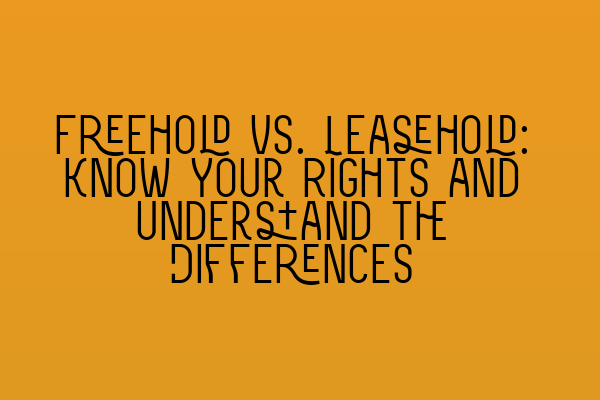Freehold vs. Leasehold: Know Your Rights and Understand the Differences
As a property owner or buyer, understanding the difference between freehold and leasehold is crucial in order to make informed decisions and protect your rights. Whether you are looking to purchase a property or are already a property owner, it is important to have a clear understanding of the terms and conditions associated with your property’s tenure. In this article, we will delve into the differences between freehold and leasehold, and highlight the rights and responsibilities that come with each.
Freehold Properties
Freehold properties refer to properties that are owned outright, giving the owner complete control and ownership over the land and any buildings on it. When you purchase a freehold property, you become the actual owner of the land and the property, giving you the right to occupy and use the property as you please. Freehold properties are usually houses or bungalows, but can also include flats within a freehold building.
One of the key advantages of owning a freehold property is that you have complete control over your property and the land it sits on. This means that you are not required to pay any ground rent or service charges, and you have the freedom to make alterations and improvements to your property without seeking permission from a landlord. You also do not have to worry about the lease term coming to an end, as you own the property indefinitely.
However, as a freehold property owner, you will be solely responsible for the maintenance and repair of your property and any shared areas or communal facilities, such as driveways or gardens. You may also be responsible for adhering to any local planning regulations and obtaining necessary permits for any major renovations or extensions.
Leasehold Properties
Leasehold properties, on the other hand, involve the ownership of a property for a fixed period of time, as specified in the lease agreement. When you purchase a leasehold property, you essentially become a tenant with a long-term lease on the property, subject to the terms and conditions set out in the lease.
Leasehold properties are often flats or apartments within a larger building, although some houses may also be sold on a leasehold basis. In the case of flats, a leasehold arrangement allows for shared ownership of the building and common areas, such as stairwells, hallways, and gardens, with other leaseholders.
One of the primary differences between owning a freehold and a leasehold property is that in a leasehold arrangement, you will be required to pay an annual ground rent to the freeholder. Additionally, service charges may be payable to cover the costs of maintenance, repairs, and insurance for the building and any shared areas. These charges are typically collected by a management company on behalf of the freeholder.
The lease agreement will outline the rights and responsibilities of both the leaseholder and the freeholder. It will specify the duration of the lease, any restrictions on alterations or use of the property, and any obligations to seek permission from the freeholder for certain actions.
Leasehold properties also come with another potential drawback – the lease term. Most leasehold properties have a fixed lease term, typically ranging from 99 to 125 years. As the lease term decreases, the value of the property may also decrease, potentially making it difficult to sell or remortgage in the future. It is important to be aware of the remaining lease term when purchasing a leasehold property and consider the implications it may have.
Leasehold Reforms and Your Rights
In recent years, leasehold reforms have been implemented to improve the rights and protection of leasehold property owners. These reforms aim to tackle issues such as unfair ground rent terms, excessive service charges, and onerous leasehold terms.
The government has introduced measures to restrict the use of ground rent and make it easier for leaseholders to extend their leases or purchase the freehold of their property. These reforms offer leaseholders more control over their properties and protection against unfair practices by freeholders.
If you are a leasehold property owner or considering purchasing a leasehold property, it is important to familiarize yourself with these reforms and understand your rights and options. Consulting with a property law solicitor who specializes in leasehold matters can provide you with invaluable advice and guidance in navigating leasehold regulations and protecting your interests.
Conclusion
Understanding the difference between freehold and leasehold properties is crucial for property owners and buyers. While freehold properties offer complete ownership and control, leasehold properties involve a lease agreement with certain obligations and restrictions.
Whether you are considering purchasing a property or already own a property, knowing your rights and responsibilities will enable you to make informed decisions and protect your interests. Seek professional advice from a property law solicitor who specializes in property law and leasehold matters to ensure that you are well-informed and protected in all property-related transactions.
Related Articles:
– SQE 1 Practice Exam Questions
– SQE 1 Practice Mocks FLK1 FLK2
– SQE 2 Preparation Courses
– SQE 1 Preparation Courses
– SRA SQE Exam Dates
